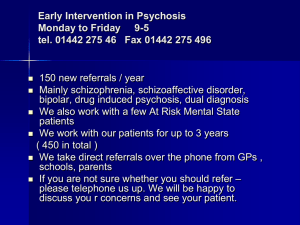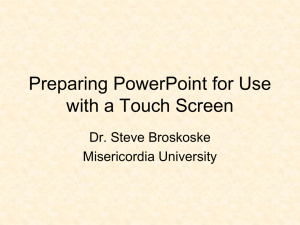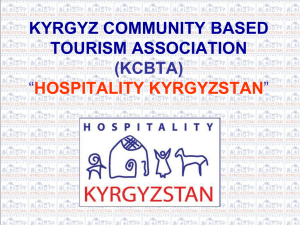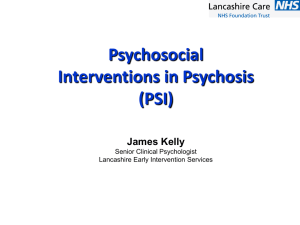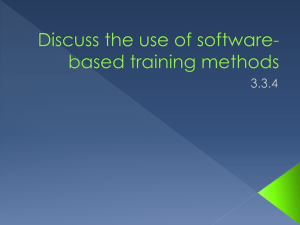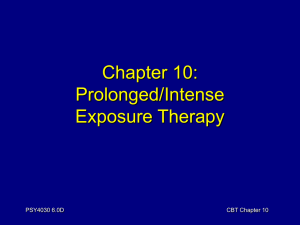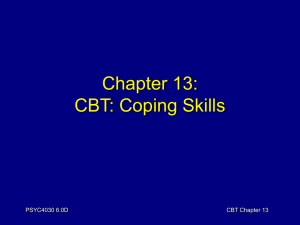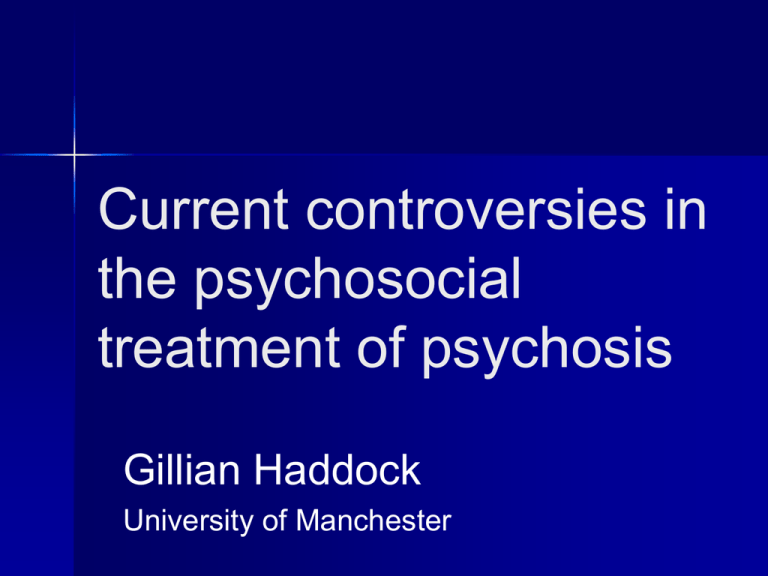
Current controversies in
the psychosocial
treatment of psychosis
Gillian Haddock
University of Manchester
Manchester
Britain’s
3rd largest city
Population of over £4m
Industrial heritage, for cotton
and textiles
Manchester Town Hall
And also….
Three universities…..
At
Manchester University there
are,
28,000 undergraduates
9,000 postgraduates
12,000 staff
Mixture of old…
And very new…
Famous for….
Father of physics – Ernest Rutherford
And…..
Kilburn and Williams with the first
‘computer’ (Baby)
Key areas of psychological
treatment in schizophrenia
Behavioural approaches e.g. social and other
skills training, contingency management etc,
generalisability??
Neuropsychological and cognitive remediation
– some progress in influencing underlying
processes, generalisability??
Family interventions - good evidence for
reducing relapse - ?inpatient settings – some
evidence
Individual cognitive behaviour therapy
Evidence on individual cognitive
behaviour therapy for psychosis
Massive literature on cognitive and
behavioural treatments; CBT (over 100
years)
Lots of case series papers over many
years (see Beck, 1952)
Last 30 years, CBT evaluated in many
randomised controlled trials
UK government guidance on CBT is
based on these trials
Individual CBT research
has focused on….
Mainly, chronic, treatment
resistant psychosis
Acute, inpatients
Recent onset and prodromal
Complex cases e.g. those with coexisting substance use, violence,
forensic, and learning difficulties
Reviews of CBT
There have been a number of reviews
of the efficacy of CBT
Overall demonstrate that CBT superior
to treatment as usual and control
treatments with small to medium
effect sizes (Jauhar et al, 2014, 50
studies; Wykes et al, 2008, 34 studies)
Wykes et al (2008)
review (Sz Bulletin, 34, 523-537)
Reviewed 34 studies (excluded those which
were not ‘purely’ CBT)
CBT had effect size of 0.4 (CI 0.252-0.548) on
target symptoms
Also improvements for negative symptoms,
functioning, mood (effect sizes 0.35-0.44)
However, more rigorous trials had lower
effect sizes i.e. non blinded studies had 50100% inflation of effect sizes
Meta-analysis of effect sizes for CBTp on positive (P),
negative symptoms (N), social functioning (F), mood (M),
hopelessness (H), social anxiety (SA) and target
symptom (T): (Wykes et al, 2008)
0.5
0.4
0.3
0.2
effect sizes
0.1
0
-0.1
-0.2
P
N
F
M
H
SA
T
Nevertheless…..
Although in the UK, psychological
treatments are now a recommended
treatment for schizophrenia
And, government guidelines state that:
– Cognitive behaviour therapy should be
offered to all people with schizophrenia
– Start in the acute phase, or later, including
inpatient settings
Despite recommendations….
National implementation is poor
“No voice, no choice”: a joint review of adult
community mental health services in England
(2007) suggested 46% service users offered
CBT
Rethink survey of 500 service users – only
14% had received CBT
Recent Manchester survey also suggested
implementation was poor
Individual and family CBT
audit in Manchester (2013)
Individual CBT:
– Offered
– Referred for
– Received
33 (18%)
23 (12%)
13 (7%)
Family intervention
(51% of sample had
family contact)
– Offered
– Referred
– Received
3 (1.6%)
2 (1.2%)
2 (1.2%)
What might be the
problem?
Services not well geared up for delivery –
lots of trained staff but emphasis on case
management – therapy not prioritised
CBT not a panacea - may not be suitable
for everyone
People with psychosis – heterogenous
population - different populations may
need different interventions
And… does everyone
want therapy?
Explored in the NIHR funded SelfHelp Therapy and Recovery Trial
(STAR-T; Haddock et al, 2014)
Aimed to explore people’s
preferences for psychological
treatment and how they would
like it delivered
4 treatment options
CBT recovery guide & telephone CBT
– weekly telephone CBT over 12 months
Recovery guide telephone and group
– weekly telephone CBT over 12 months
and group support sessions fortnightly for
6 months facilitated by a CBT therapist
and a Service User Researcher
Treatment as usual alone
Or.., randomisation
Who took part…..
N = 97, male = 63%
Mean age = 35
Mixed sample, mixed ethnicity and
service type (36% first episode)
We found that:
– Only 2 chose to be randomised
– Many people chose treatment as usual
TAU
LOW SUPPORT
26%
36%
HIGH SUPPORT
37%
Developments in CBT for psychosis
with specific populations….
CBT to reduce full transition to psychosis
in prodromal psychosis (Morrison et al, 2012)
CBT plus motivational interviewing for
psychosis and substance misuse (Haddock
et al, 2003; Barrowclough et al, 2010)
CBT for people with psychosis and
learning difficulties (Haddock et al, 2003)
CBT for specific symptoms e.g. hallucinations
(Birchwood et al, 2011)
CBT for those with psychosis and
violence problems (Haddock et al, 2009)
What can we conclude?
Psychological
treatments are
effective for many people
But, not every one wants
therapy – some people happy as
they are
Different populations need
modifications to treatments
Working with in complex
settings with complex
issues in psychosis
Anger, aggression, violence and
substance misuse
Therapeutic approaches for
complex clients?
Treatments are not yet well
evaluated for these groups in these
settings
So, can we use CBT and other
approaches which are designed for
other groups for these problems in
these settings?
Key features of complex
clients in secure settings
Persistent, treatment resistant
symptoms
Violence/self harm
Anger
Unmotivated?
Difficult interpersonal environment
Result in significant personal, service,
staff and public challenges
Schizo killer
caged for life
Schizo cabbie knifed
six
DC killed by
freed patient
SICK KILLER LOCKED UP
But, people with
schizophrenia….
Commit only a small proportion of
violent crime
Only 5% of homicides committed by
people with a diagnosis of Sz (National Suicide
and Homicide Survey, 2006)
More likely to be victims of aggression
and violence than the general
population (11 x general populaton; Teplin et al, 2005)
Schizophrenia and
violence
Although many studies link
schizophrenia to increased violence….
Not consistent findings, methodological
problems with research (e.g. different
populations, prospective vs.
retrospective designs etc)
Base rates low
Depending on type of violence, people
with Sz have slightly higher rates BUT
confounded by other factors
?not helpful to look at diagnosis
Other contributory
factors…….
substance use
personality disorder
anger
hostility
environment
delusions
gender
command hallucinations
Key areas of work in
Manchester in complex cases
Understanding the role of:
– Psychosis
– Anger
– Substance use
– Interpersonal environment
Is the severity of psychotic
symptoms linked with violence?
Difficult to tell precisely, methodological
issues in the research
Some evidence that delusions are linked
to increased violence but other factors
e.g. substance misuse, anger etc may
inflate this
However, content or type of symptom
seems more important than severity
Manchester violence
prospective study (Haddock, Barrowclough,
Novaco, Cross and Tarrier, 2014)
77 people with diagnosis of Sz and
history of violence followed up over 12
months
Severity of symptoms not linked to
increased violence
Those with paranoia and/or delusions
of control were more violent
And, they were more angry
Command hallucinations
and aggression/violence
Studies shows type of command (harm
other/harm self etc) not really linked to
compliance
But beliefs about the entity giving the
commands are linked to compliance (Beck-Sander
et al, 1997; Barrowcliff and Haddock, 2010, Bucci et al, 2013) e.g.
Believing commander justified in making the command
associated with violence to others
Believing the commander to be omnipotent = violence to
others (especially when combined with impulsivity)
Believing commander to be benign associated with self harm
So, specific symptoms and beliefs about them
play a key role in violence and aggression
Anger and psychosis
Anger commonly experienced by those
with psychosis, particularly inpatient
settings
Anger consistently associated with
aggression/violence in general population
Similarly, anger predictive of
violence/aggression in psychotic samples
(Novaco and Renwick, 1998; Doyle and Dolan, 2007)
Due to…. disagreement about treatment,
feeling disrespect, being criticised……
Important cognitive
themes linked to anger
Thinking about being provoked
Suspiciousness
Sensitive to disrespect
Beliefs about voices
Rumination
Feeling justified for anger
Sensitive to criticism
Substance use and
psychosis?
Rates of substance use higher in
psychosis samples than in ‘normal’
population
Problematic within inpatient settings and
often history of substance misuse not
addressed – ongoing unresolved problem
?Leads to more untreated symptoms, less
engagement with treatment, disinhibition,
emotional problems…..
Why do people with
psychosis use substances?
To control unpleasant feelings
To manage psychotic symptoms
To control side effects of meds.
To feel ‘normal’
To fit in with a social group
To have fun (when most mental health
services are not that fun, especially
secure and inpatient services!)
People with psychosis have many
positive experiences from substances
Drowns out voices
Reduces social anxiety or paranoia
Helps depression
Stops bad thoughts
Enhances magical experiences
Helps you think more
Have a good time
Talk more fluently
Brain works better
Feel normal
More energy
Better sex More confidence
Helps relax
Interpersonal environment
and psychosis
Interpersonal environment has long been
demonstrated to contribute to outcome in Sz
(e.g. expressed emotion)
Environment has been clearly related to
relapse of symptoms, aggression/violence (e.g.
Barrowclough et al, 2001)
This has been highlighted in family
environments and in staff and inpatient
environments
Psychiatric services often under-resourced, low
staff morale and high staff turnover
The Observer, April 8, 2007
(quote taken from mental health nurse,
anonymous)
'Those working on acute psychiatric wards
live in parallel worlds filled with horrors that
no one on the outside could ever try to
imagine. We see atrocities every day and
take them for normal. ‘
‘Every morning, we brace ourselves for
mayhem: I could start my day witnessing an
attack on another member of staff or a
patient, or even be attacked myself. The
only thing I can be sure of is that the risk of
such violence is increasing.'
Informing practice: key
issues
Type of psychotic symptoms and
beliefs about them
Anger and impulsivity
Substance use
Interpersonal environment
The PICASSO
programme
Haddock et al, (2009) Br.J. Psychiatry
(Psychological interventions for coping with anger
in schizophrenia: study of options)
PICASSO clinical sample
In contact with mental health
services (in or outpatient)
DSM-IV schizophrenia or
schizoaffective disorder
Hallucinations & delusions
History of violence/aggression
‘Treatment resistant’ and
unmotivated
Challenges faced….
Dual diagnoses (Violence and aggression,
learning difficulties, self harm, personality
issues, substance use)
Multiple problems: persistent psychosis,
anger, depression, anxiety, interpersonal
difficulties…
Adverse life history, criminal convictions,
poor social networks, poor family
relationships……
Environmental challenges
Security factors over-ride aesthetics, risk
management paramount
Very little individual autonomy
Staff - dual role of security and therapy
Multi-disciplinary teams, multiple models
of working
High stress, high staff turnover
Hostile, unempathic environment
PICASSO CBT treatment
programme
Individual 1-1 psychological therapy
Aimed at reducing violence by focusing on
treatment of key psychotic symptoms, anger,
substance use and interpersonal environment
Delivered over 6 months
Up to 25 sessions offered
Linked in with all staff to aid integration and
generalisation
Key features of PICASSO
CBT
Increase motivation to work on psychosis and
anger in therapy using motivational strategies
Reduce distress & disruption of psychotic
symptoms
Formulate how psychosis, anger and
aggression, substance use and interpersonal
environment are related
Provide CBT intervention for psychotic
symptoms, anger, substance use to reduce risk
of future violence integrated into interpersonal
environment
Integrating motivational
interviewing into CBT
Motivation building (from Miller and Rollnick,
2002) used as people not always keen to
change and engage in treatment
Intervening when a person is not committed to
change ineffective and unhelpful
Used as a precursor to CBT to increase
motivation and identify key goals, and….
interchangeably with CBT throughout if
motivation wanes
PICASSO social activity
therapy training programme
A control treatment which was matched
with CBT for therapy contact time
Aimed at collaboratively working with the
individual to identify pleasurable activities
Integrated into mental health treatment
as usual
Sample
325 people screened
108 probably eligible
Total eligible and consented = 77
Male n = 66
Single n = 74
Schizophrenia
90%
Schizoaffective disorder
10%
PICASSO sample:
accommodation (n)
Own Home
Supported Accommodation
Family Home (Parents)
Family Home (Spouse)
Hostel
Ward (Not Secure)
Ward (Secure)
(High secure
4
1
3
2
9
10
48
12)
Symptom profile (n)
All 4 or more on PANSS hallucinations
or delusions
Command hallucinations n = 16
Threat control over-ride
symptoms
n = 35
Mean total PANSS score
63.8
Mean PANSS positive score 18.4
Therapy participation
3 withdrew from therapy (2 CBT, 1 SAT).
1 person transferred out of region
Of the 73, all but 8 received 10 or
more sessions
Mean no. sessions: 17.0 (CBT)
17.4 (SAT)
No significant differences between no.
of sessions received or no. of minutes
of therapy received between groups.
Outcomes
Aggression
and violence
case notes
systematic review, Ward Anger Rating Scale (Novaco and Renwick
, 2001)
Risk
case notes systematic review
Anger
Novaco Anger Scale (Novaco, 2003)
Symptoms
PANSS (Kay et al, 1989) and PSYRATS
(Haddock et al, 1999)
Global
functioning (GAF)
Aggression and violence
Violence assessed from:
– case note recording of incidents extracted
by blind raters
– staff ratings based on observation on Ward
Anger Rating Scale
No differences in pre-trial (3 months)
violence between groups
Total incidents of verbal and physical
aggression over treatment and follow-up
period (ns verbal, physical p =0.004 eot, 0.076 follow-up)
350
300
250
200
Verbal
Physical
150
100
50
0
CBT
SAT
Results: risk
Risk management strategies employed
by services reduced significantly more
for those who received CBT
E.g. more leave, more access to
community, discharge…
Risk: decreased vs. stayed
the same or worsened (inpatients
only, p = 0.034)
16
14
12
10
Decreased
risk
8
6
4
2
0
CBT
SAT
Stayed
same or
worse risk
Results: anger (NAS, WARS)
Trend for all participants to be less
angry overall (no sig. group differences)
Participants felt significantly less
provoked overall at end of treatment,
not follow-up
And, staff rated whole group as less
angry & aggressive at EOT & follow-up
No treatment was superior
Results: symptoms
Improvements in both treatments at end
of treatment & follow up on overall
general psychotic symptoms (PANSS)
Significantly better outcome in CBT
group for delusions although not
hallucinations (PSYRATS)
Improvements in global functioning
overall, trend for CBT to be superior
Conclusions
An integrated CBT enhanced by
motivational interviewing can improve
outcomes for people with psychosis at
risk of violence in variety of settings
Psychosis, anger, substance use and the
interpersonal environment all have to be
considered in treatment
Enhancing CBT using motivational
strategies essential for difficult to
engage people
“...change seems to happen when the person
connects it with something important, something
cherished. Intrinsic motivation …arises in an
accepting, empowering atmosphere…the way
out of (the) forest has to do with exploring and
following what the person is experiencing and
what, from his or her perspective, truly matters.”
Miller and Rollnick, 2002
A case study illustrating the key
challenges…
Steve
25 year old man with 8 yr history of Sz
Experimenting with drugs from 15+,
mainly amphetamines, cannabis
Repeated hospitalisations for relapse,
drugs usually involved
Admission to HDU following multiple
aggressive and violent attacks on staff
Steve DVD
Problems in engagement
He didn’t want to be seen
Wouldn’t talk to anyone
Interactions were aggressive and
dismissive of attempts to engage
Often on ‘one to one’ to control
aggressive behaviour to others
Appeared very psychotic
Key therapeutic issues
Hopeless, angry, depressed, anxious
Felt completely misunderstood, beliefs
true, why didn’t they get the police?
Drugs are only thing that help him, why
were people against them?
Or, why didn’t they give him something
that had the same effect?
Current problems:
psychosis
Believed people could read his thoughts
and influence his actions
These people could also inflict pain on
him, sticking pins
He was a special person who was in
touch with many secret organisations,
reincarnation of famous ‘evil’ man
He was responsible for bad things
happening (wars, plane crashes)
Current problems: anger
Angry at people who were inflicting
pain and ‘putting things in head’
Angry at psychiatrist & staff for
locking him up & making him take
medication that he didn’t need
No-one listened, no control over
treatment hence aggression
justified
Main goals: Steve
Get out of hospital
Get a flat, own money, girlfriend
Take as many drugs as he liked
Stop medication
Main goals: staff
Reduce anger and aggression
Gain ‘insight’ and be respectful of
other’s views
Say he wouldn’t take drugs
Demonstrate some self
care/independent living skills
Take medication happily
What he thought was
important…
Might need to talk to someone to discuss what
was interfering with achieving goals
The disagreement between him and staff re
symptoms, anger and drug use had to be
resolved (prove them wrong)
Resolve confusion as to origin of his delusional
experiences: what was ‘real’ or ‘not real’
Directing energy towards goals and ‘looking
after himself’ rather than at others
Problem list: Steve’s
perspective
Disagreement about:
– diagnosis: anxiety not schizophrenia
– Getting wrong treatment
– drug taking, problem for staff not
him
Distress and anger:
– re people harming him
– towards staff and situation
Key strategies used..
Maintaining 3rd person role, mediator,
exploring beliefs in empathic way
Building self–esteem in coping with
persecutors, reducing distress, increasing
control, reducing arousal
Ensure team gave clear information re
what was required to reach goals
Agreeing formulation re anger,
aggression, psychosis with team
Team’s rules for
moving on
take prescribed medication and say
he would continue to do so
say that he wouldn’t take drugs
practice at independent living
reduce his hostility and aggression
Impact on Steve
Steve was:
– clearer about how to achieve goals
– less distressed & able to explore and
question beliefs
– clearer on role of substance use in
his difficulties
– reduced anger and arousal
For example…
Came to conclusion that some of his beliefs
in past probably were due to Schizophrenia
(famous evil man) and substance use
Changed to another medication that he was
happier with, controlled his anxiety better
Was given opportunity to progress, realised
he had more control over future, more hope
that goals were achievable
What can we conclude?
CBT is definitely helpful for chronic,
treatment resistant psychosis in reducing
symptoms
Acute and inpatient psychosis benefits
from CBT, may speed recovery
Growing evidence with forensic and
complex presentations evaluation with
more complex groups e.g. in forensic
settings
CBT acceptable, low attrition



